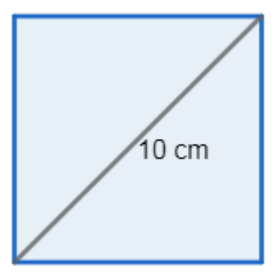Answer
409.2k+ views
Hint: In this question, first let us draw the diagram with the given conditions. Then from the value of the diagonal of the square, we can get the value of the side. Now, substitute the side in the area formula to get the result.
Complete step-by-step solution -
Now, given in the question the diagonal of the square is 10 cm.

SQUARE: A rectangle is a square in which all four sides are equal. Hence, the diagonals are equal and they bisect at right angles.
Diagonal of a square is given by the formula
\[\sqrt{2}a\]
Area of a square is given by the formula
\[{{a}^{2}}\]
Let us assume the side of the square as a
Now, on comparing the given value of diagonal with the formula we get,
\[\Rightarrow \sqrt{2}a=10\]
Let us now divide with the square root of 2 on both the sides
\[\therefore a=\dfrac{10}{\sqrt{2}}\]
Now, let us find the area of the square with the above obtained side
Let us assume the area of the square as A
\[\Rightarrow A={{a}^{2}}\]
Now, on substituting the value of the side in the above formula we get,
\[\Rightarrow A={{\left( \dfrac{10}{\sqrt{2}} \right)}^{2}}\]
Now, on squaring the respective terms we get,
\[\Rightarrow A=\dfrac{100}{2}\]
Now, on further simplification we get,
\[\therefore A=50c{{m}^{2}}\]
Hence, the correct option is (c).
Note: Instead of finding the value of the side to find the area we can also get the area directly from the relation between the diagonal and area. Both methods give the same result. It is important to note that the given value in the question is diagonal not side because substituting the value of diagonal in the area formula instead of side changes the result.
Complete step-by-step solution -
Now, given in the question the diagonal of the square is 10 cm.

SQUARE: A rectangle is a square in which all four sides are equal. Hence, the diagonals are equal and they bisect at right angles.
Diagonal of a square is given by the formula
\[\sqrt{2}a\]
Area of a square is given by the formula
\[{{a}^{2}}\]
Let us assume the side of the square as a
Now, on comparing the given value of diagonal with the formula we get,
\[\Rightarrow \sqrt{2}a=10\]
Let us now divide with the square root of 2 on both the sides
\[\therefore a=\dfrac{10}{\sqrt{2}}\]
Now, let us find the area of the square with the above obtained side
Let us assume the area of the square as A
\[\Rightarrow A={{a}^{2}}\]
Now, on substituting the value of the side in the above formula we get,
\[\Rightarrow A={{\left( \dfrac{10}{\sqrt{2}} \right)}^{2}}\]
Now, on squaring the respective terms we get,
\[\Rightarrow A=\dfrac{100}{2}\]
Now, on further simplification we get,
\[\therefore A=50c{{m}^{2}}\]
Hence, the correct option is (c).
Note: Instead of finding the value of the side to find the area we can also get the area directly from the relation between the diagonal and area. Both methods give the same result. It is important to note that the given value in the question is diagonal not side because substituting the value of diagonal in the area formula instead of side changes the result.
Recently Updated Pages
The branch of science which deals with nature and natural class 10 physics CBSE

The Equation xxx + 2 is Satisfied when x is Equal to Class 10 Maths

Define absolute refractive index of a medium

Find out what do the algal bloom and redtides sign class 10 biology CBSE

Prove that the function fleft x right xn is continuous class 12 maths CBSE

Find the values of other five trigonometric functions class 10 maths CBSE

Trending doubts
Difference Between Plant Cell and Animal Cell

Difference between Prokaryotic cell and Eukaryotic class 11 biology CBSE

Fill the blanks with the suitable prepositions 1 The class 9 english CBSE

Change the following sentences into negative and interrogative class 10 english CBSE

Summary of the poem Where the Mind is Without Fear class 8 english CBSE

Give 10 examples for herbs , shrubs , climbers , creepers

Write an application to the principal requesting five class 10 english CBSE

What organs are located on the left side of your body class 11 biology CBSE

What is the z value for a 90 95 and 99 percent confidence class 11 maths CBSE



